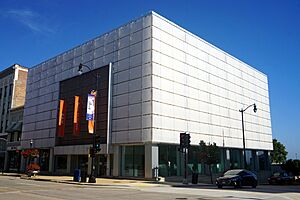Racine Art Museum facts for kids
| Racine Art Museum and RAM's Charles A. Wustum Museum of Fine Arts | |
 |
|
| Established | November 16, 1941 |
|---|---|
| Location | Racine, Wisconsin |
| Type | Contemporary craft |
| Visitors | 60,000 per year (2017) |
| Public transit access | |
The Racine Art Museum (RAM) is a cool place in Racine, Wisconsin, USA. It's famous for having the biggest collection of modern craft art in North America. They have over 9,500 amazing pieces made by artists from all over the world. The museum wants to show everyone that craft art is just as important as paintings and sculptures. They collect, save, and teach people about modern art.
Contents
How the Museum Started
The Racine Art Museum actually began thanks to a kind woman named Jennie E. Wustum. When she passed away in 1938, she left her house and land to the City of Racine. Her wish was for it to become a public art museum and park.
In 1941, her wish came true! The property became the Charles A. Wustum Museum of Fine Arts. It opened its doors on November 16, 1941. The first art show featured 96 paintings by artists from Wisconsin.
Early Art Collections
The museum's permanent collection started with a big gift of 294 artworks. These pieces came from a special government program called the Works Progress Administration (WPA). This collection included textiles, paintings, photographs, and block prints. These WPA artworks are still shown in special exhibits sometimes, with the most recent one in 2017.
In the 1980s, the museum started to focus on collecting crafts made by American artists. A very generous person named Karen Johnson Boyd donated over 1,750 items. These included works by famous artists like Dale Chihuly, known for his glass art, and Wendell Castle, who made amazing furniture. These high-quality donations encouraged other collectors to give their art too. This is how RAM grew to have the largest collection of contemporary craft art in North America.
The Downtown Museum
In 2000, the museum expanded! It opened a new location in downtown Racine. This new building was an old bank from 1874. It was completely updated to become a modern art space.
The new building has a unique look. It has clear acrylic panels around the top two floors. These panels let the building's original stone show through during the day. At night, they light up, making the museum glow! This expansion made the museum much bigger, adding a sculpture garden and an art library. The original museum building is still used for art classes and local art shows.
What You Can See: The Collections
RAM's permanent collection has over 9,500 artworks. These are from artists known around the world. Here are some of the types of art you can find there:
- Ceramics: There are over 1,500 ceramic pieces, including works by artists like Toshiko Takaezu. The museum also has one of the largest collections of ceramic teapots in the United States, with over 500 teapots from the 1950s to the 2000s!
- Fibers: This collection has over 450 objects. Many of these are sculptures made using weaving or basket-making techniques.
- Glass: You can see beautiful glass art from artists like Dale Chihuly and Harvey Littleton.
- Metals: There are over 1,200 metal artworks. These include pieces by artists like Albert Paley, who creates large metal sculptures.
- Wood: This section features turned wooden bowls and unique furniture. A special piece is a desk by Wendell Castle.
- Handmade Books: The museum also collects books that are made by hand. These include books with hand-printed pages and larger art books.

